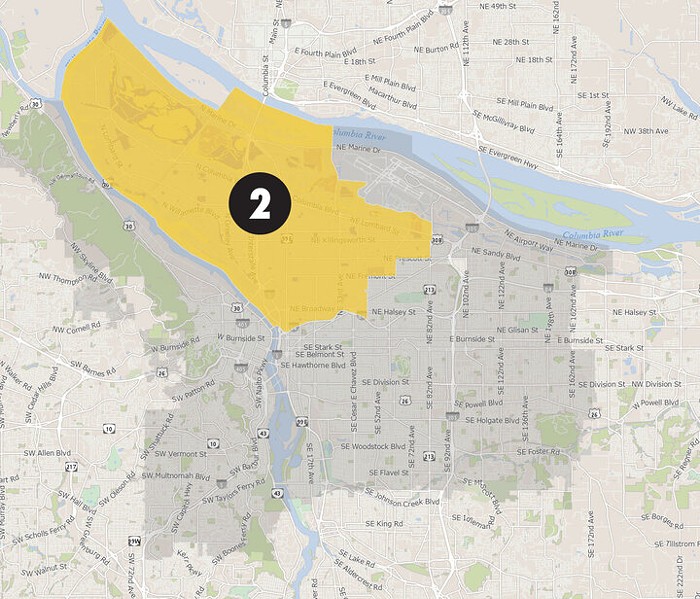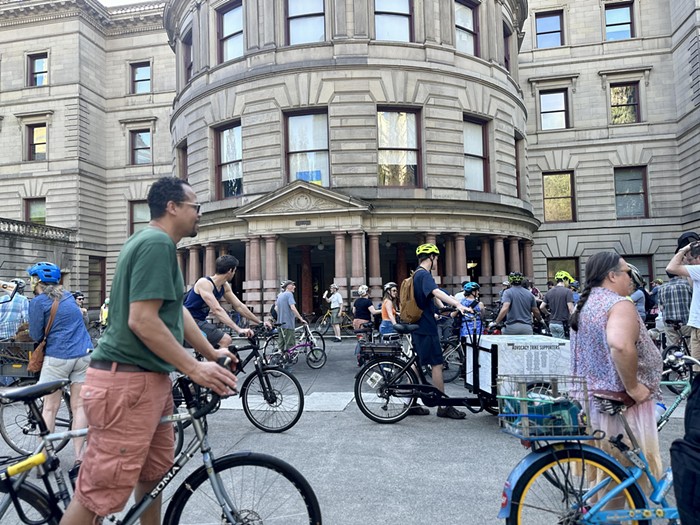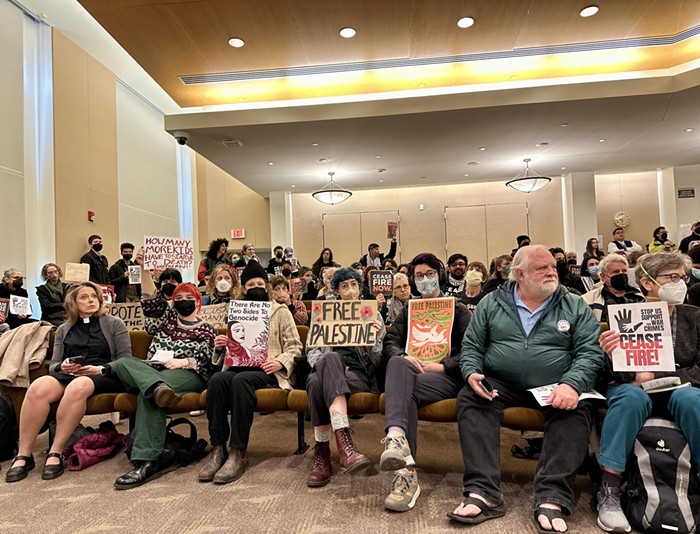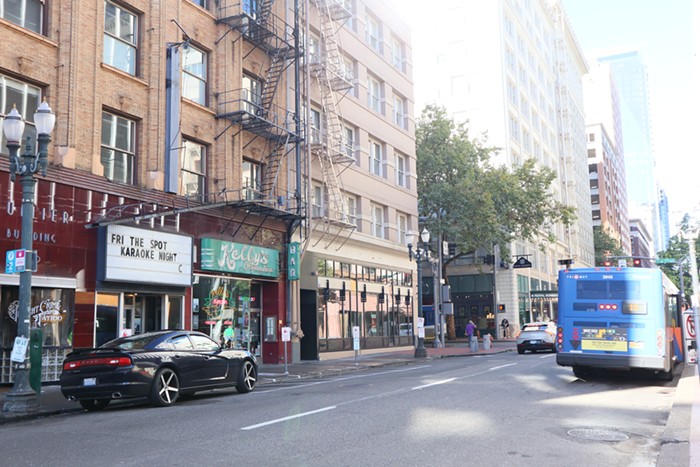Tracey Sparling put herself in harm's way last October 11, the day she hopped on her bicycle and rolled down SW 14th toward class at Pacific Northwest College of Art—at least according to some media accounts.
The 19-year-old woman was obeying the law, riding in the bike lane, and stopping at a red light on W Burnside. In the lane to her left, Timothy Wiles piloted a cement truck carrying 40,000 pounds of concrete. When the light turned green, he turned right. "As he did so, Ms. Sparling apparently moved forward a short distance... and was run over by the right front wheel of Wiles' truck. She was then run over by one or both sets of rear wheels," according to a memo from Senior Deputy District Attorney Chuck Sparks.
Sparling died in the street that day, beneath the Crystal Ballroom's neon marquee.
The following day, hundreds of cyclists rode in a slow, nearly silent procession from the Burnside Bridge to the site of her death.
A day after that, Lt. Mark Kruger of the Portland Police Department's Traffic Division supplied excuses for the driver, to the Oregonian.
"Motorists have been conditioned for 100 years that no one is going to pass them on the right," Kruger told the Oregonian. "Spring forward to where we are today, where we've added bike lanes to the mix, and some bicycles are traveling at high speed. It can lead to significant, deadly conflicts, as we saw Thursday.
"Bicyclists expect and are trained by activists groups that when you've got the bike lane, you can do what you want to do. We have a lot of these collisions that don't end in fatalities, but they are stubborn to the point that they won't give up ground for the sake of safety."
Until last Thursday, January 10, that was effectively the end of the story in the public eye: Sparling put herself in harm's way, and suffered the consequences.
"They always blame the cyclist," says Susie Kubota, Sparling's aunt. Kubota has spoken at street safety rallies, and in support of City Commissioner Sam Adams' transportation plan, which includes funds for bike-safety improvements. "The police shouldn't make it sound like drivers don't need to do anything differently—like it's all cyclists' fault," Kubota says.
"You're legally abiding by a system the city has established, and not only do you get killed," says Jonathan Maus, of BikePortland.org, "but people insinuate that you played a role in your own death."
THE BLIND SPOT
On Thursday, January 10—nearly three months to the day of Sparling's death—Senior Deputy District Attorney Sparks issued his memo, outlining the decision not to prosecute Wiles for criminal homicide.
The news wasn't surprising. Of the six cyclists killed on Portland's streets in 2007, four died following collisions with vehicles. The driver who collided with Nick Bucher on SE Stark in February wasn't charged or cited, though he'd been drinking (but wasn't over the legal limit). Two women involved in the May hit and run on SE Foster that claimed Jerry Hinatsu's life received two months' jail time in a plea deal, but were not found guilty of felony hit-and-run charges. The driver in Sparling's case hasn't been charged or—to date—cited. And five days after the DA released the Sparling decision, he announced that Bryan Lowes, the man driving the garbage truck that crushed cyclist Brett Jarolimek last October 22, would not be charged, either.
Sparks' memo outlines why he opted not to charge the driver in Sparling's case. In short, the driver didn't perceive Sparling's presence next to his truck, so turning wasn't criminally negligent.
"[The driver, Timothy] Wiles arrived at the intersection before Ms. Sparling and came to a stop, waiting to turn right. Wiles did not see Ms. Sparling as she approached his stopped truck, nor did he see her as he went into his turn," Sparks wrote in his memo. "Ms. Sparling stopped in the bike lane near Wiles' right front wheel, and was, due to her location and diminutive stature, not visible to Wiles; she was, through no fault of her own, in the driver's blind spot....
"The relevant standard is criminal negligence. Criminal negligence is the failure to be aware of 'a substantial and unjustifiable risk that the result will occur or the circumstance exists,' with the risk being 'of such nature and degree that the failure to be aware of it constitutes a gross deviation from the standard of care that a reasonable person would observe in the situation.' The evidence must prove beyond a reasonable doubt that Mr. Wiles acted with criminal negligence for the state to prosecute. After reviewing all witness statements, the scene evidence, and the toxicology reports I conclude that Wiles' failure to perceive Ms. Sparling prior to his turn was not sufficient to charge him with criminally negligent homicide."
While it's clear that Sparling was in Wiles' blind spot (and, according to Sparks' second memo, Jarolimek was in Lowes'), Sparks' memo does raise the question of how aware drivers must be of what could be in that space—especially when it overlaps a bike lane. Shouldn't the driver have assumed someone could be there, and waited for bike traffic—visible or not—to clear?
The DA has to make decisions "from a criminal negligence standpoint," Sparks says. "Is it provable beyond a reasonable doubt that [the driver] acted with criminal negligence? I don't think it is." And it's not his place, he points out, "to file charges to send a message" to every other driver on the road. "You can't use a human being to do that."
The blind-spot issue "leaves us at a gray, unanswered place," says Maus. "As a society, you have a situation where people can be legally operating their vehicle on a city street and one of them can kill the other or do something that causes the death, and there's absolutely no mechanism of accountability.
"If that's the conclusion we come to, that you have to know the person's there, you have to be able to perceive that someone's there, to be accountable for moving into the right of way..." Maus says. "If that's the conclusion that we're going to move forward with, what does that say about us?"
WHO'S ACCOUNTABLE?
The Sparling case is now on a police investigator's desk, and that investigator will decide whether or not to cite the driver (cops don't cite drivers on the scene of fatal collisions, following a district attorney directive).
"I don't think we really expected criminal charges, necessarily," says Sparling's aunt Kubota. But she's holding out hope that the police will now issue a citation for failing to yield to a cyclist in the bike lane.
"Even though it's a very minor infraction, I at least want to know there's something. Because there's got to be something to make drivers realize there's a consequence—no matter how minor—to them personally" when a cyclist is injured or killed.
Sparling's parents were unavailable for comment by press time; Kubota does not know if they plan to pursue legal action, but Sparling's father brought an attorney with him when he arrived at the district attorney's office on January 10 to hear the charging decision.
If the police don't issue a citation, Maus says the police need to find a creative solution for accountability.
"We need some sort of middle ground. Compromised accountability that doesn't hang someone publicly, but shows the public that a mistake was made, and it was serious," he says, suggesting a new kind of citation. "Call it something different. If you violated a law and violated someone's right of way that they were legally occupying, then that's a mistake for which you need to be legally held accountable."
Meanwhile, without criminal charges—and in the absence of a citation—the public perception remains: Sparling's death was her own fault, for hopping on a bike that day and using a bike lane in a legal manner.


















